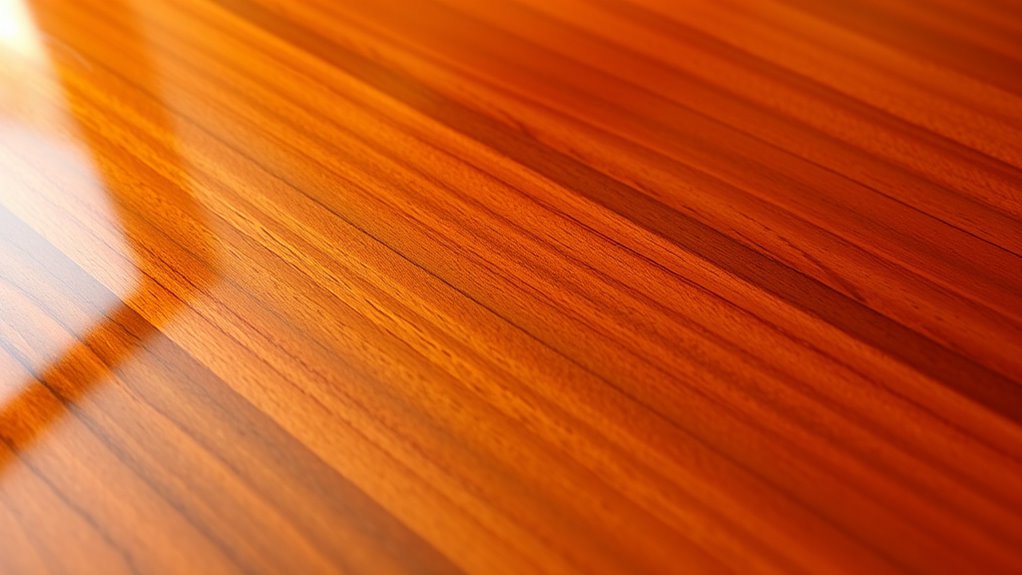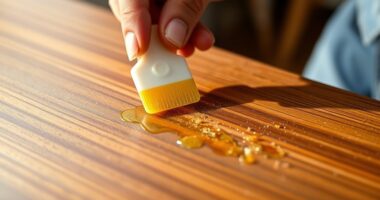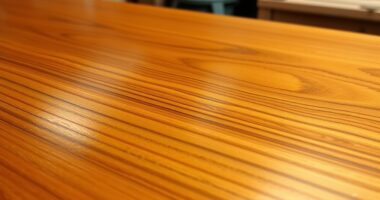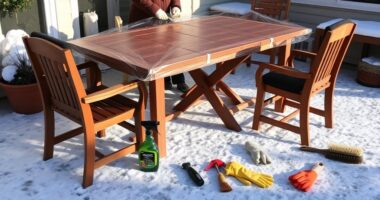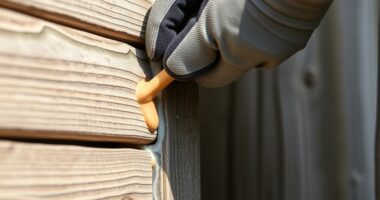To achieve a mirror-gloss shellac finish with the French polishing method, start by thoroughly preparing your surface—clean and lightly sand along the grain. Use thin coats of shellac on a polishing pad or soft cloth, applying with smooth, circular motions along the grain. Allow each layer to dry completely, then gently sand with fine abrasive before adding the next. Mastering these steps will bring out a stunning, reflective finish—continue and you’ll discover even more refinements to perfect your look.
Key Takeaways
- Prepare the surface thoroughly by cleaning, sanding with fine-grit paper, and removing dust to ensure shellac adhesion.
- Apply thin, even coats of shellac along the wood grain using a polishing pad or soft cloth.
- Lightly sand with fine abrasive between coats to smooth imperfections and enhance gloss.
- Build up multiple layers gradually, allowing each to dry completely for depth and clarity.
- Achieve a mirror gloss through careful layering, proper surface prep, and attentive application techniques.
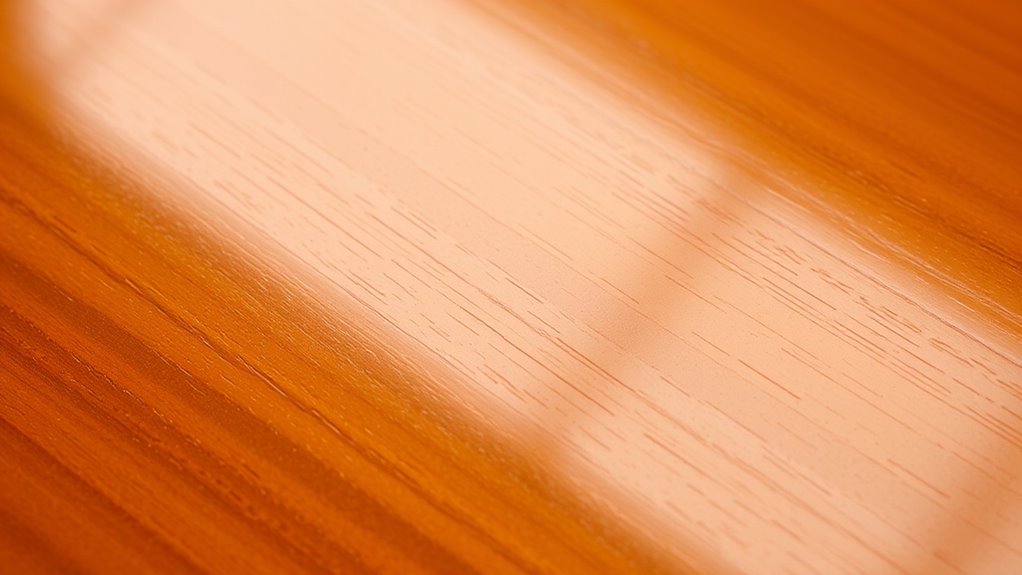
French polishing is a traditional technique used to create a smooth, glossy finish on wood surfaces. When you undertake this process, understanding the importance of the wood grain and surface preparation is essential. The way the wood grain runs influences how the shellac layers adhere and reflect light, so paying close attention to the grain’s direction helps you achieve an even, mirror-like shine. Before you begin, take the time to prepare the surface thoroughly. Proper surface preparation involves cleaning the wood, removing any dust, dirt, or old finishes, and sanding it smooth. You want the surface to be as flawless as possible because imperfections will show through the high-gloss shellac finish.
French polishing requires careful surface prep and attention to the wood grain for a flawless, mirror-like finish.
Start by selecting the right type of wood and guaranteeing it’s properly cured. Once you’ve chosen your piece, use fine-grit sandpaper to gently smooth out the surface, following the natural wood grain. This step is essential because it reveals the true character of the wood and assures the shellac will adhere uniformly. After sanding, remove all dust using a tack cloth or a damp cloth to prevent particles from settling into the shellac layers. Any dust or debris can cause bumps or imperfections in the finished surface, so meticulous cleaning is crucial.
When you’re ready to apply shellac, use a high-quality polishing pad or a soft cloth dipped in shellac solution. Work along the direction of the wood grain, applying thin, even coats. It’s tempting to try to rush the process, but patience is key here. Allow each coat to dry completely before applying the next. As you build up layers, you’ll notice the surface start to develop that characteristic deep gloss. Your goal is to gradually increase the sheen without creating drips or uneven spots.
As you progress, pay close attention to the surface’s appearance and feel. Lightly sand with fine abrasive between coats if necessary, always following the wood grain. This step helps smooth out any tiny imperfections and enhances the clarity of the shellac. Over time, with multiple thin coats, the surface will begin to reflect light like a mirror. The final result depends on your careful surface preparation and attention to the wood grain during application. When finished, you’ll have a stunning, high-gloss surface that showcases the natural beauty of the wood and demonstrates the timeless elegance of the French polishing method. Additionally, understanding how surface preparation impacts the final finish can help you achieve a more professional and durable result.
Frequently Asked Questions
How Long Does It Take to Achieve a Mirror-Gloss Shellac Finish?
Achieving a mirror-gloss shellac finish depends on your drying time and polishing techniques. Typically, it takes about 1 to 2 hours for each coat to dry thoroughly, but multiple coats may be needed. You’ll want to carefully sand and polish between layers to get that high-gloss look. With patience and proper technique, you can reach that stunning mirror gloss in a few days.
Can the French Polishing Method Be Used on All Wood Types?
While French polishing offers stunning finish versatility, it’s not suitable for all wood types. You might find it perfect for soft, porous woods like mahogany or walnut, but it can be problematic on oily or resinous woods like teak or oak. Wood compatibility varies, so consider the surface’s absorption and finish requirements. For the best results, test a small area first to ascertain your chosen wood can handle the delicate, high-gloss French polishing technique.
What Safety Precautions Are Necessary During French Polishing?
When French polishing, you should wear protective gear like gloves and a mask to prevent skin and inhalation of fumes. Guarantee good ventilation safety by working in a well-ventilated area or using fans to disperse vapors. Avoid open flames, as the polishing compounds are flammable. Take these precautions seriously to protect your health and safety while achieving professional results with French polishing.
How Durable Is a Mirror-Gloss Shellac Finish Over Time?
You’ll find that a mirror-gloss shellac finish can be quite durable over time if properly maintained. Its finish durability depends on factors like exposure to moisture and handling. To keep it looking its best, follow maintenance tips such as regular dusting and avoiding harsh cleaners. Reapplying thin coats of shellac periodically helps preserve the finish’s luster and resilience, ensuring your piece remains stunning for years.
Is Special Equipment Required for French Polishing Compared to Other Methods?
You don’t need specialized tools for French polishing compared to other methods, but proper surface preparation is essential. You’ll use basic equipment like cotton pads, polishing compounds, and a hand applicator, focusing on patience and technique. Unlike some finishes requiring power tools, French polishing relies on skill and gentle, repetitive motions. Ensuring your surface is well-prepared will help achieve a smooth, mirror-gloss finish without the need for expensive or complex equipment.
Conclusion
Now that you’ve mastered the French polishing technique, you’re well on your way to achieving that stunning mirror-gloss shellac finish. Just remember, patience and practice are your best friends; don’t expect perfection overnight. With each gentle stroke, you’re painting a masterpiece, turning a simple piece into a work of art. Keep at it, and soon you’ll see your efforts pay off—like a diamond in the rough, your craftsmanship will truly shine through.
